2005 SUBARU FORESTER tire size
[x] Cancel search: tire sizePage 67 of 477
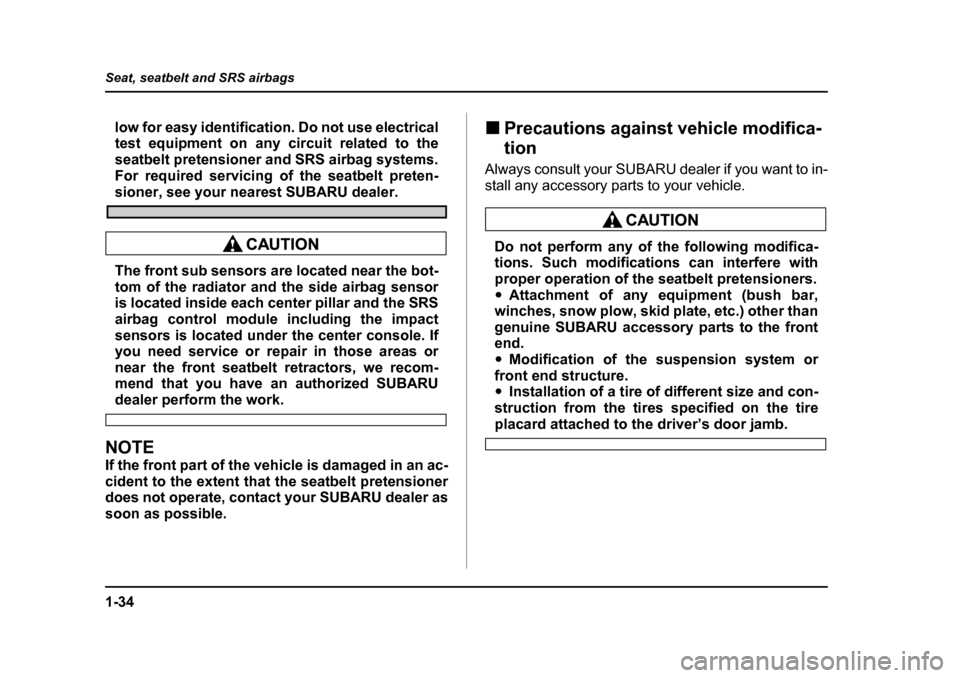
1-34
Seat, seatbelt and SRS airbags
low for easy identification. Do not use electrical
test equipment on any circuit related to the
seatbelt pretensioner and SRS airbag systems.
For required servicing of the seatbelt preten-
sioner, see your nearest SUBARU dealer.
The front sub sensors are located near the bot-
tom of the radiator and the side airbag sensor
is located inside each center pillar and the SRS
airbag control module including the impact
sensors is located under the center console. If
you need service or repair in those areas or
near the front seatbelt retractors, we recom-
mend that you have an authorized SUBARU
dealer perform the work.
NOTE
If the front part of the vehicle is damaged in an ac-
cident to the extent that the seatbelt pretensioner
does not operate, contact your SUBARU dealer as
soon as possible.
�„
Precautions against vehicle modifica- tion
Always consult your SUBARU dealer if you want to in-
stall any accessory parts to your vehicle.
Do not perform any of the following modifica-
tions. Such modifications can interfere with
proper operation of the seatbelt pretensioners.�y Attachment of any equipment (bush bar,
winches, snow plow, skid plate, etc.) other than
genuine SUBARU accessory parts to the front
end. �y Modification of the suspension system or
front end structure. �y Installation of a tire of different size and con-
struction from the tires specified on the tire
placard attached to the driver’s door jamb.
Page 109 of 477
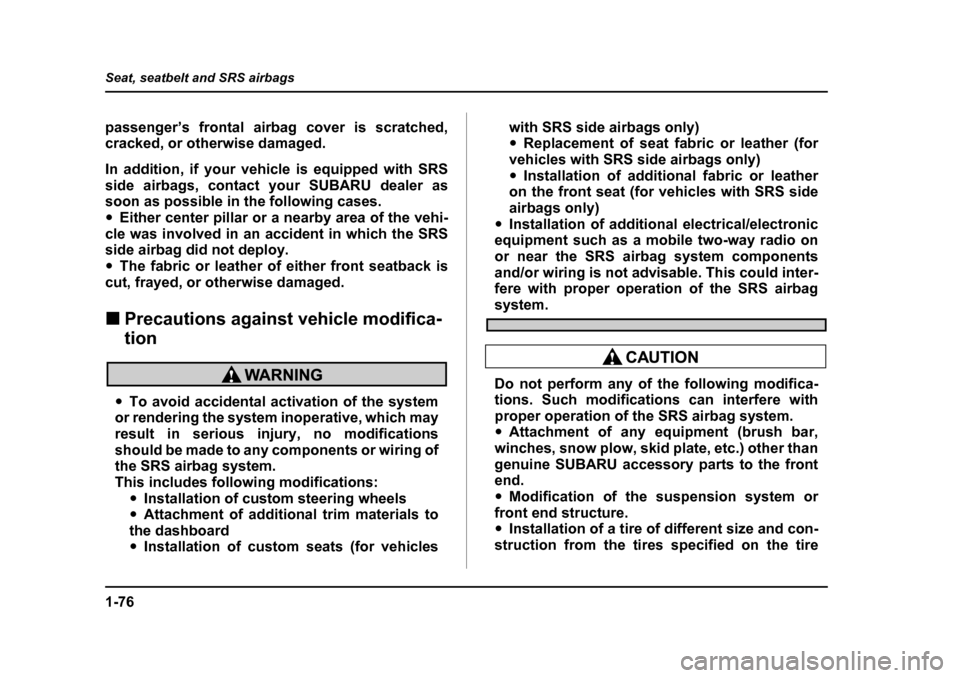
1-76
Seat, seatbelt and SRS airbags
passenger’s frontal airbag cover is scratched,
cracked, or otherwise damaged.
In addition, if your vehicle is equipped with SRS
side airbags, contact your SUBARU dealer as
soon as possible in the following cases.�y
Either center pillar or a nearby area of the vehi-
cle was involved in an accident in which the SRS
side airbag did not deploy.�y The fabric or leather of either front seatback is
cut, frayed, or otherwise damaged. �„ Precautions against vehicle modifica- tion
�yTo avoid accidental activation of the system
or rendering the system inoperative, which may
result in serious injury, no modifications
should be made to any components or wiring of
the SRS airbag system.
This includes following modifications: �yInstallation of custom steering wheels
�y Attachment of additional trim materials to
the dashboard �y Installation of custom seats (for vehicles with SRS side airbags only)�y
Replacement of seat fabric or leather (for
vehicles with SRS side airbags only) �y Installation of additional fabric or leather
on the front seat (for vehicles with SRS side
airbags only)
�y Installation of additional electrical/electronic
equipment such as a mobile two-way radio on
or near the SRS airbag system components
and/or wiring is not advisable. This could inter-
fere with proper operation of the SRS airbag
system.
Do not perform any of the following modifica-
tions. Such modifications can interfere with
proper operation of the SRS airbag system. �y Attachment of any equipment (brush bar,
winches, snow plow, skid plate, etc.) other than
genuine SUBARU accessory parts to the front
end. �y Modification of the suspension system or
front end structure. �y Installation of a tire of different size and con-
struction from the tires specified on the tire
Page 278 of 477
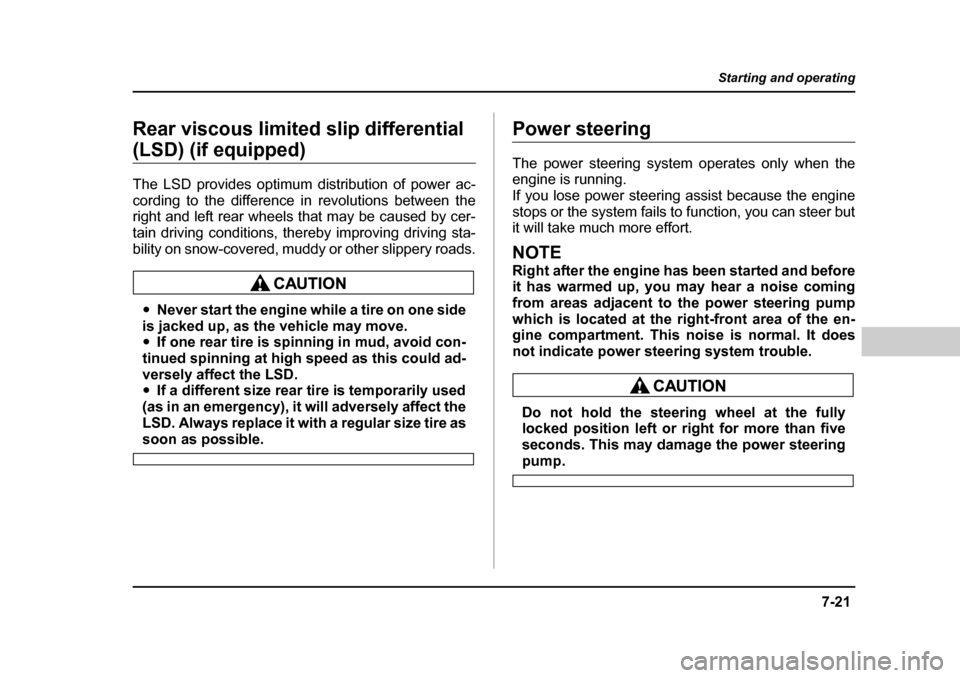
7-21
Starting and operating
– CONTINUED –
Rear viscous limited slip differential
(LSD) (if equipped)
The LSD provides optimum distribution of power ac-
cording to the difference in revolutions between the
right and left rear wheels that may be caused by cer-
tain driving conditions, thereby improving driving sta-
bility on snow-covered, muddy or other slippery roads.
�yNever start the engine while a tire on one side
is jacked up, as the vehicle may move. �y If one rear tire is spinning in mud, avoid con-
tinued spinning at high speed as this could ad-
versely affect the LSD.�y If a different size rear tire is temporarily used
(as in an emergency), it will adversely affect the
LSD. Always replace it with a regular size tire as
soon as possible.
Power steering
The power steering system operates only when the
engine is running.
If you lose power steering assist because the engine
stops or the system fails to function, you can steer but
it will take much more effort.
NOTE
Right after the engine has been started and before
it has warmed up, you may hear a noise coming
from areas adjacent to the power steering pump
which is located at the right-front area of the en-
gine compartment. This noise is normal. It does
not indicate power steering system trouble.
Do not hold the steering wheel at the fully
locked position left or right for more than five
seconds. This may damage the power steering
pump.
Page 285 of 477
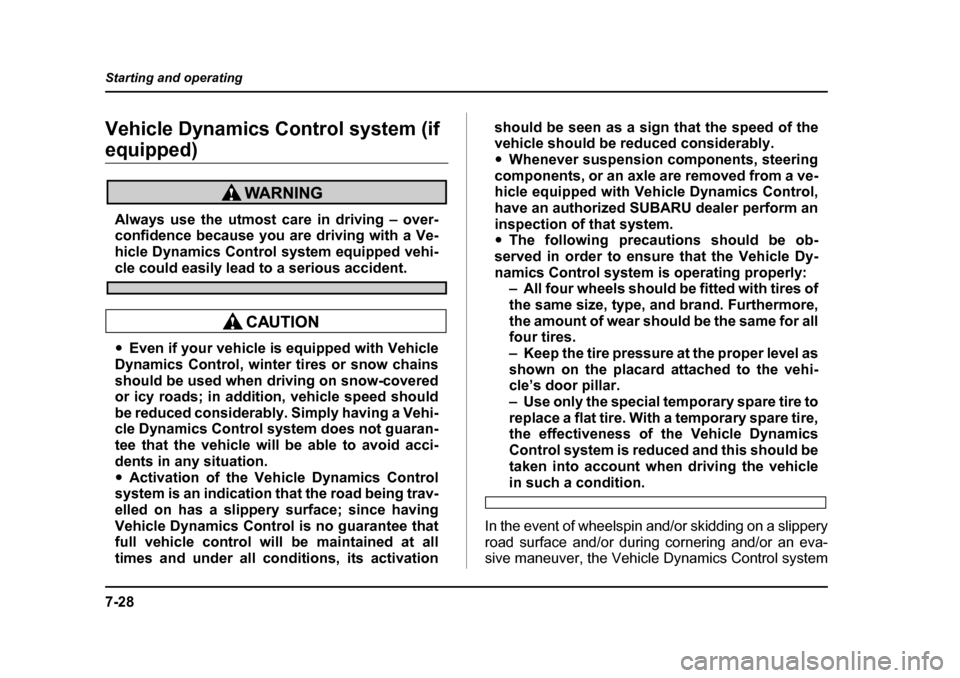
7-28
Starting and operating
Vehicle Dynamics Control system (if
equipped)
Always use the utmost care in driving – over-
confidence because you are driving with a Ve-
hicle Dynamics Control system equipped vehi-
cle could easily lead to a serious accident.
�y
Even if your vehicle is equipped with Vehicle
Dynamics Control, winter tires or snow chains
should be used when driving on snow-covered
or icy roads; in addition, vehicle speed should
be reduced considerably. Simply having a Vehi-
cle Dynamics Control system does not guaran-
tee that the vehicle will be able to avoid acci-
dents in any situation.�y Activation of the Vehicle Dynamics Control
system is an indication that the road being trav-
elled on has a slippery surface; since having
Vehicle Dynamics Control is no guarantee that
full vehicle control will be maintained at all
times and under all conditions, its activation should be seen as a sign that the speed of the
vehicle should be reduced considerably.�y
Whenever suspension components, steering
components, or an axle are removed from a ve-
hicle equipped with Vehicle Dynamics Control,
have an authorized SUBARU dealer perform an
inspection of that system. �y The following precautions should be ob-
served in order to ensure that the Vehicle Dy-
namics Control system is operating properly: – All four wheels should be fitted with tires of
the same size, type, and brand. Furthermore,
the amount of wear should be the same for all four tires.
– Keep the tire pressure at the proper level as
shown on the placard attached to the vehi-
cle’s door pillar.
– Use only the special temporary spare tire to
replace a flat tire. With a temporary spare tire,
the effectiveness of the Vehicle Dynamics
Control system is reduced and this should be
taken into account when driving the vehicle
in such a condition.
In the event of wheelspin and/or skidding on a slippery
road surface and/or during cornering and/or an eva-
sive maneuver, the Vehicle Dynamics Control system
Page 287 of 477
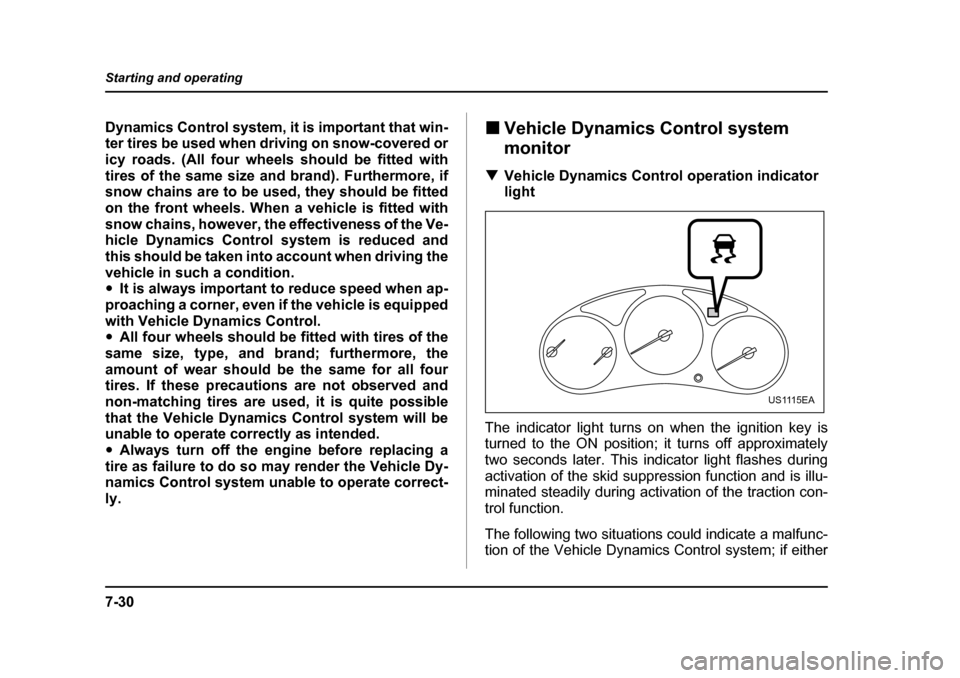
7-30
Starting and operating
Dynamics Control system, it is important that win-
ter tires be used when driving on snow-covered oricy roads. (All four wheels should be fitted with
tires of the same size and brand). Furthermore, if
snow chains are to be used, they should be fitted
on the front wheels. When a vehicle is fitted with
snow chains, however, the effectiveness of the Ve-
hicle Dynamics Control system is reduced and
this should be taken into account when driving the
vehicle in such a condition. �y
It is always important to reduce speed when ap-
proaching a corner, even if the vehicle is equipped
with Vehicle Dynamics Control. �y All four wheels should be fitted with tires of the
same size, type, and brand; furthermore, the
amount of wear should be the same for all four
tires. If these precautions are not observed and
non-matching tires are used, it is quite possible
that the Vehicle Dynamics Control system will be
unable to operate correctly as intended.�y Always turn off the engine before replacing a
tire as failure to do so may render the Vehicle Dy-
namics Control system unable to operate correct-ly. �„
Vehicle Dynamics Control system monitor
�T Vehicle Dynamics Control operation indicator
light
The indicator light turns on when the ignition key is
turned to the ON position; it turns off approximately
two seconds later. This indicator light flashes during
activation of the skid suppression function and is illu-
minated steadily during activation of the traction con-
trol function.
The following two situations could indicate a malfunc-
tion of the Vehicle Dynamics Control system; if either
US1115EA
Page 308 of 477
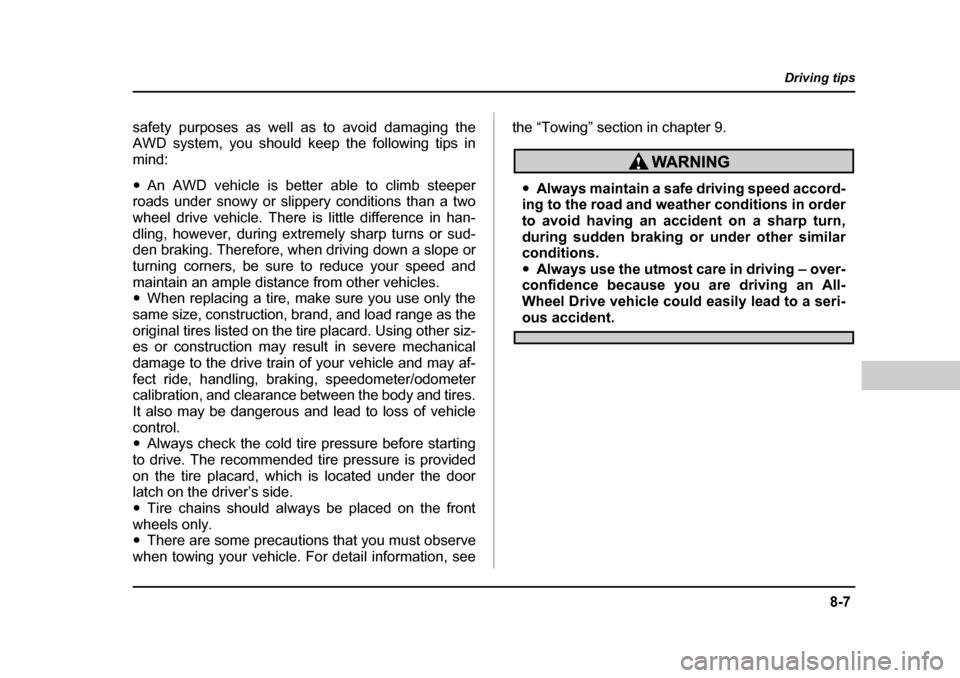
8-7
Driving tips
– CONTINUED –
safety purposes as well as to avoid damaging the
AWD system, you should keep the following tips inmind: �yAn AWD vehicle is better able to climb steeper
roads under snowy or slippery conditions than a two
wheel drive vehicle. There is little difference in han-
dling, however, during extremely sharp turns or sud-
den braking. Therefore, when driving down a slope or
turning corners, be sure to reduce your speed and
maintain an ample distance from other vehicles. �y When replacing a tire, make sure you use only the
same size, construction, brand, and load range as the
original tires listed on the tire placard. Using other siz-
es or construction may result in severe mechanical
damage to the drive train of your vehicle and may af-
fect ride, handling, braking, speedometer/odometer
calibration, and clearance between the body and tires.
It also may be dangerous and lead to loss of vehicle
control. �y Always check the cold tire pressure before starting
to drive. The recommended tire pressure is provided
on the tire placard, which is located under the door
latch on the driver’s side.�y Tire chains should always be placed on the front
wheels only.�y There are some precautions that you must observe
when towing your vehicle. For detail information, see the “Towing” section in chapter 9.
�y
Always maintain a safe driving speed accord-
ing to the road and weather conditions in order
to avoid having an accident on a sharp turn,
during sudden braking or under other similar
conditions. �y Always use the utmost care in driving – over-
confidence because you are driving an All-
Wheel Drive vehicle could easily lead to a seri-
ous accident.
Page 314 of 477
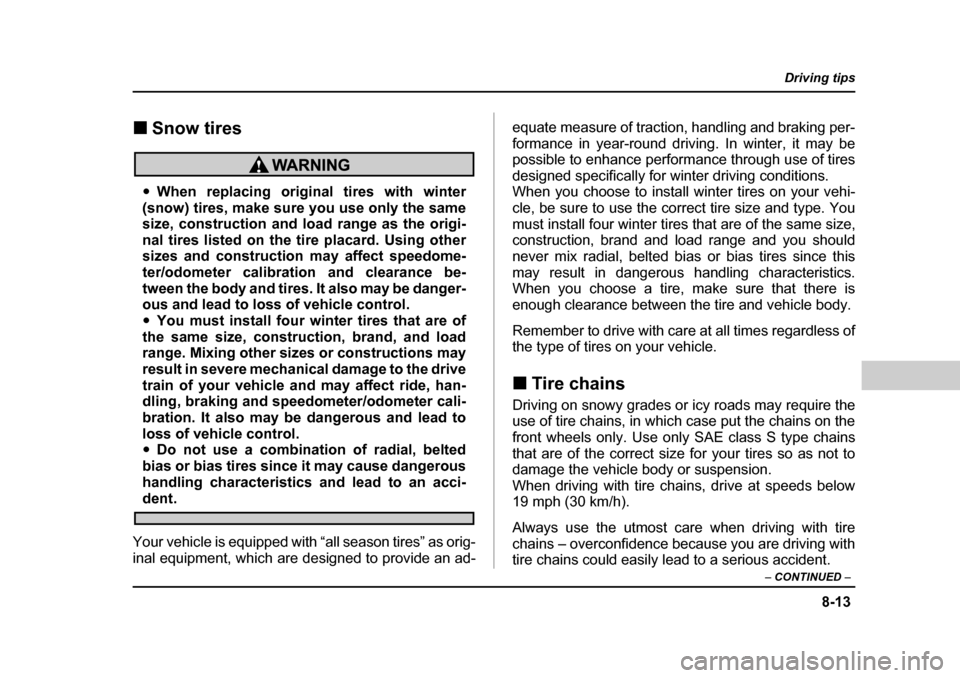
8-13
Driving tips
– CONTINUED –
�„Snow tires
�yWhen replacing original tires with winter
(snow) tires, make sure you use only the same
size, construction and load range as the origi-
nal tires listed on the tire placard. Using other
sizes and construction may affect speedome-
ter/odometer calibration and clearance be-
tween the body and tires. It also may be danger-
ous and lead to loss of vehicle control. �y You must install four winter tires that are of
the same size, construction, brand, and load
range. Mixing other sizes or constructions may
result in severe mechanical damage to the drive
train of your vehicle and may affect ride, han-
dling, braking and speedometer/odometer cali-
bration. It also may be dangerous and lead to
loss of vehicle control. �y Do not use a combination of radial, belted
bias or bias tires since it may cause dangerous
handling characteristics and lead to an acci-
dent.
Your vehicle is equipped with “all season tires” as orig-
inal equipment, which are designed to provide an ad- equate measure of traction, handling and braking per-
formance in year-round driving. In winter, it may be
possible to enhance performance through use of tires
designed specifically for winter driving conditions.
When you choose to install winter tires on your vehi-
cle, be sure to use the correct tire size and type. You
must install four winter tires that are of the same size,
construction, brand and load range and you should
never mix radial, belted bias or bias tires since this
may result in dangerous handling characteristics.
When you choose a tire, make sure that there is
enough clearance between the tire and vehicle body.
Remember to drive with care at all times regardless of
the type of tires on your vehicle. �„
Tire chains
Driving on snowy grades or icy roads may require the
use of tire chains, in which case put the chains on the
front wheels only. Use only SAE class S type chains
that are of the correct size for your tires so as not to
damage the vehicle body or suspension.
When driving with tire chains, drive at speeds below
19 mph (30 km/h).
Always use the utmost care when driving with tire
chains – overconfidence because you are driving with
tire chains could easily lead to a serious accident.
Page 332 of 477
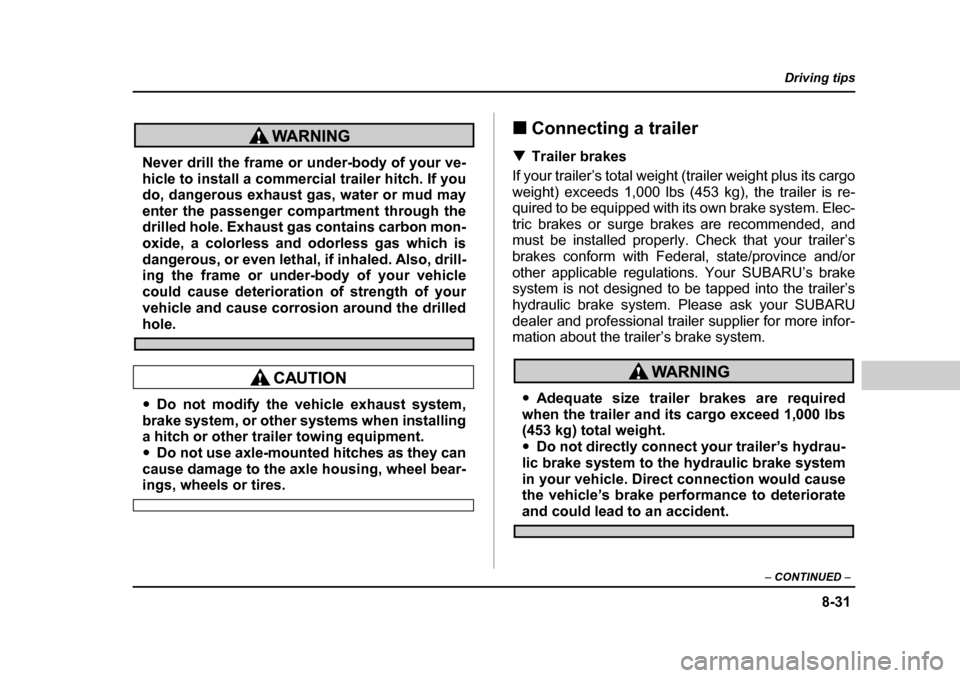
8-31
Driving tips
– CONTINUED –
Never drill the frame or under-body of your ve-
hicle to install a commercial trailer hitch. If you
do, dangerous exhaust gas, water or mud may
enter the passenger compartment through the
drilled hole. Exhaust gas contains carbon mon-
oxide, a colorless and odorless gas which is
dangerous, or even lethal, if inhaled. Also, drill-
ing the frame or under-body of your vehicle
could cause deterioration of strength of your
vehicle and cause corrosion around the drilled
hole.
�yDo not modify the vehicle exhaust system,
brake system, or other systems when installing
a hitch or other trailer towing equipment. �y Do not use axle-mounted hitches as they can
cause damage to the axle housing, wheel bear-
ings, wheels or tires. �„
Connecting a trailer
�T Trailer brakes
If your trailer’s total weight (trailer weight plus its cargo
weight) exceeds 1,000 lbs (453 kg), the trailer is re-
quired to be equipped with its own brake system. Elec-
tric brakes or surge brakes are recommended, and
must be installed properly. Check that your trailer’s
brakes conform with Federal, state/province and/or
other applicable regulations. Your SUBARU’s brake
system is not designed to be tapped into the trailer’s
hydraulic brake system. Please ask your SUBARU
dealer and professional trailer supplier for more infor-
mation about the trailer’s brake system.
�y Adequate size trailer brakes are required
when the trailer and its cargo exceed 1,000 lbs
(453 kg) total weight.�y Do not directly connect your trailer’s hydrau-
lic brake system to the hydraulic brake system
in your vehicle. Direct connection would cause
the vehicle’s brake performance to deteriorate
and could lead to an accident.